BMP4005: IT Systems, Globalization, and Digital Infrastructure
VerifiedAdded on 2023/06/08
|9
|2303
|112
Report
AI Summary
This report, prepared for the BSC (Hons) Business Management with Foundation program, delves into the crucial role of Information Technology in business success. It begins by describing theories, methods, and techniques related to the design and development of MOODLE and MS OFFICE, highlighting their importance in enhancing productivity and efficiency. The report then defines and provides examples for various information systems such as DSS, ESS, TPS, MIS, and KSM, showcasing their applications in different business functions. Furthermore, it explores the impact of IT on globalization, examining the evolution of technology and its effects on interconnectedness. The report also provides examples of digital infrastructure, including mobile telecom and cloud services, discussing their advantages and disadvantages. The conclusion emphasizes the significance of IT companies and software in modern business operations, reinforcing the importance of information systems in achieving organizational objectives. The report uses examples and references to support the arguments made. It provides a good overview of the role of IT in business management.
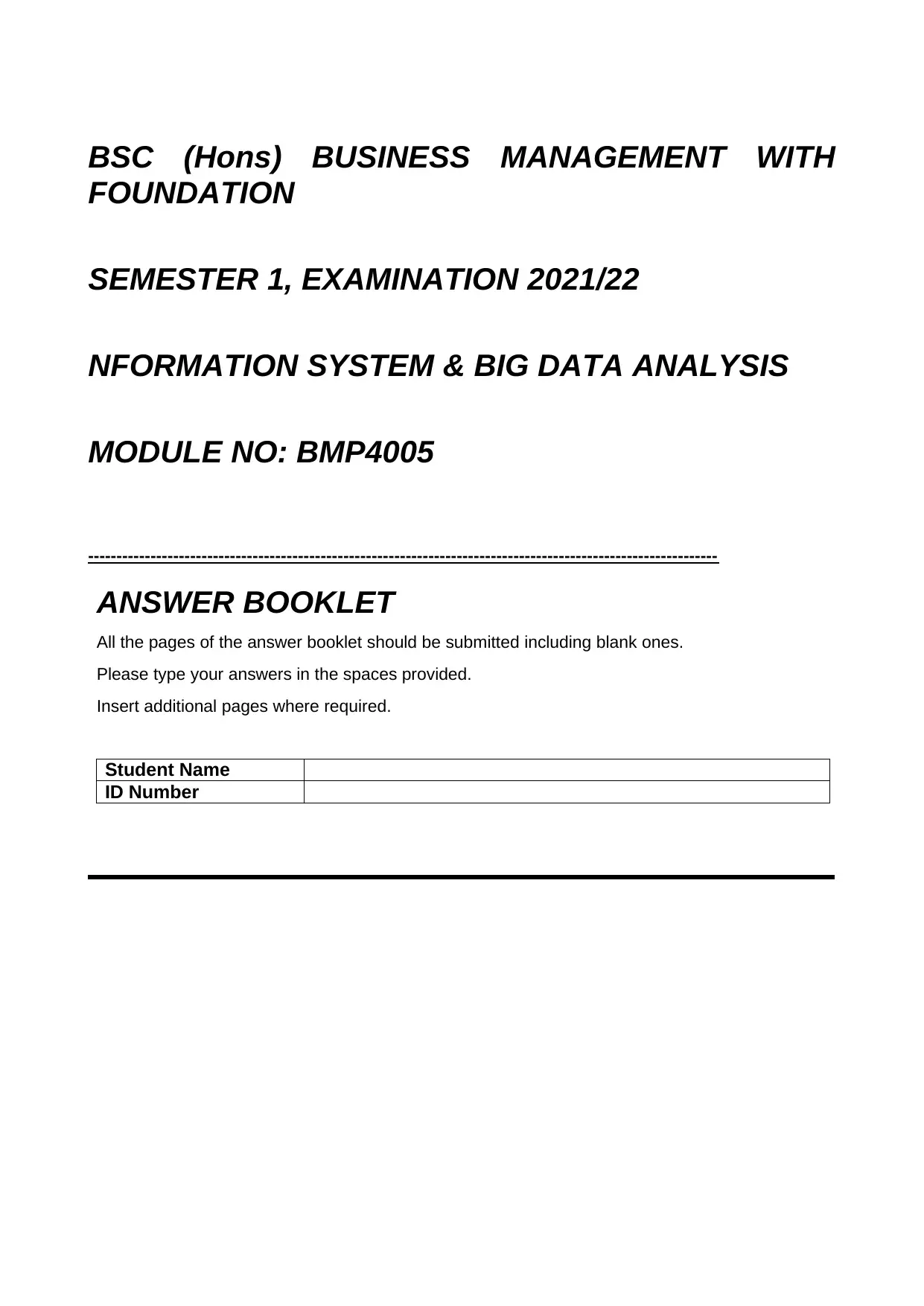
BSC (Hons) BUSINESS MANAGEMENT WITH
FOUNDATION
SEMESTER 1, EXAMINATION 2021/22
NFORMATION SYSTEM & BIG DATA ANALYSIS
MODULE NO: BMP4005
---------------------------------------------------------------------------------------------------------------
ANSWER BOOKLET
All the pages of the answer booklet should be submitted including blank ones.
Please type your answers in the spaces provided.
Insert additional pages where required.
Student Name
ID Number
FOUNDATION
SEMESTER 1, EXAMINATION 2021/22
NFORMATION SYSTEM & BIG DATA ANALYSIS
MODULE NO: BMP4005
---------------------------------------------------------------------------------------------------------------
ANSWER BOOKLET
All the pages of the answer booklet should be submitted including blank ones.
Please type your answers in the spaces provided.
Insert additional pages where required.
Student Name
ID Number
Paraphrase This Document
Need a fresh take? Get an instant paraphrase of this document with our AI Paraphraser

2 of 10
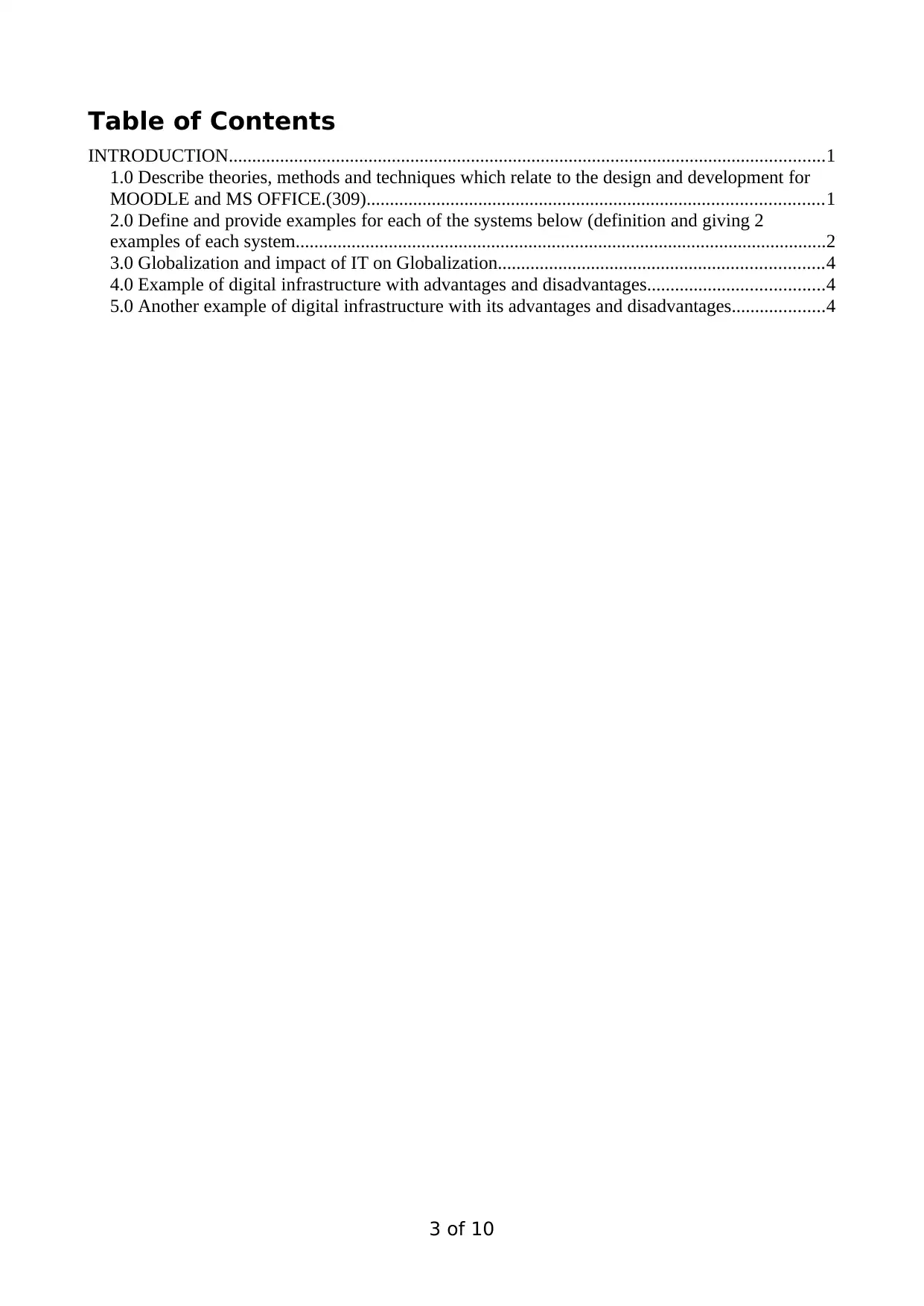
Table of Contents
INTRODUCTION................................................................................................................................1
1.0 Describe theories, methods and techniques which relate to the design and development for
MOODLE and MS OFFICE.(309)..................................................................................................1
2.0 Define and provide examples for each of the systems below (definition and giving 2
examples of each system..................................................................................................................2
3.0 Globalization and impact of IT on Globalization......................................................................4
4.0 Example of digital infrastructure with advantages and disadvantages......................................4
5.0 Another example of digital infrastructure with its advantages and disadvantages....................4
3 of 10
INTRODUCTION................................................................................................................................1
1.0 Describe theories, methods and techniques which relate to the design and development for
MOODLE and MS OFFICE.(309)..................................................................................................1
2.0 Define and provide examples for each of the systems below (definition and giving 2
examples of each system..................................................................................................................2
3.0 Globalization and impact of IT on Globalization......................................................................4
4.0 Example of digital infrastructure with advantages and disadvantages......................................4
5.0 Another example of digital infrastructure with its advantages and disadvantages....................4
3 of 10
⊘ This is a preview!⊘
Do you want full access?
Subscribe today to unlock all pages.

Trusted by 1+ million students worldwide
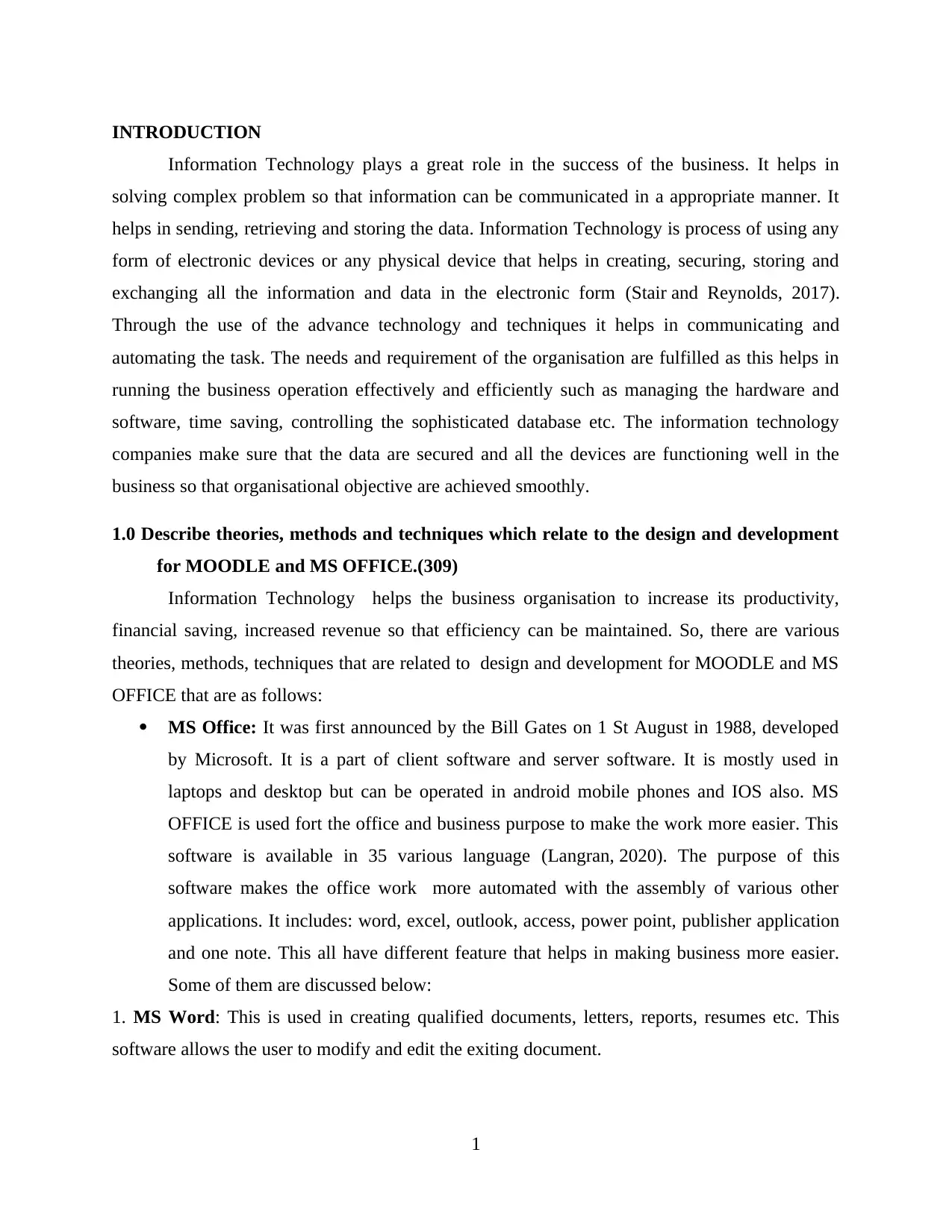
INTRODUCTION
Information Technology plays a great role in the success of the business. It helps in
solving complex problem so that information can be communicated in a appropriate manner. It
helps in sending, retrieving and storing the data. Information Technology is process of using any
form of electronic devices or any physical device that helps in creating, securing, storing and
exchanging all the information and data in the electronic form (Stair and Reynolds, 2017).
Through the use of the advance technology and techniques it helps in communicating and
automating the task. The needs and requirement of the organisation are fulfilled as this helps in
running the business operation effectively and efficiently such as managing the hardware and
software, time saving, controlling the sophisticated database etc. The information technology
companies make sure that the data are secured and all the devices are functioning well in the
business so that organisational objective are achieved smoothly.
1.0 Describe theories, methods and techniques which relate to the design and development
for MOODLE and MS OFFICE.(309)
Information Technology helps the business organisation to increase its productivity,
financial saving, increased revenue so that efficiency can be maintained. So, there are various
theories, methods, techniques that are related to design and development for MOODLE and MS
OFFICE that are as follows:
MS Office: It was first announced by the Bill Gates on 1 St August in 1988, developed
by Microsoft. It is a part of client software and server software. It is mostly used in
laptops and desktop but can be operated in android mobile phones and IOS also. MS
OFFICE is used fort the office and business purpose to make the work more easier. This
software is available in 35 various language (Langran, 2020). The purpose of this
software makes the office work more automated with the assembly of various other
applications. It includes: word, excel, outlook, access, power point, publisher application
and one note. This all have different feature that helps in making business more easier.
Some of them are discussed below:
1. MS Word: This is used in creating qualified documents, letters, reports, resumes etc. This
software allows the user to modify and edit the exiting document.
1
Information Technology plays a great role in the success of the business. It helps in
solving complex problem so that information can be communicated in a appropriate manner. It
helps in sending, retrieving and storing the data. Information Technology is process of using any
form of electronic devices or any physical device that helps in creating, securing, storing and
exchanging all the information and data in the electronic form (Stair and Reynolds, 2017).
Through the use of the advance technology and techniques it helps in communicating and
automating the task. The needs and requirement of the organisation are fulfilled as this helps in
running the business operation effectively and efficiently such as managing the hardware and
software, time saving, controlling the sophisticated database etc. The information technology
companies make sure that the data are secured and all the devices are functioning well in the
business so that organisational objective are achieved smoothly.
1.0 Describe theories, methods and techniques which relate to the design and development
for MOODLE and MS OFFICE.(309)
Information Technology helps the business organisation to increase its productivity,
financial saving, increased revenue so that efficiency can be maintained. So, there are various
theories, methods, techniques that are related to design and development for MOODLE and MS
OFFICE that are as follows:
MS Office: It was first announced by the Bill Gates on 1 St August in 1988, developed
by Microsoft. It is a part of client software and server software. It is mostly used in
laptops and desktop but can be operated in android mobile phones and IOS also. MS
OFFICE is used fort the office and business purpose to make the work more easier. This
software is available in 35 various language (Langran, 2020). The purpose of this
software makes the office work more automated with the assembly of various other
applications. It includes: word, excel, outlook, access, power point, publisher application
and one note. This all have different feature that helps in making business more easier.
Some of them are discussed below:
1. MS Word: This is used in creating qualified documents, letters, reports, resumes etc. This
software allows the user to modify and edit the exiting document.
1
Paraphrase This Document
Need a fresh take? Get an instant paraphrase of this document with our AI Paraphraser
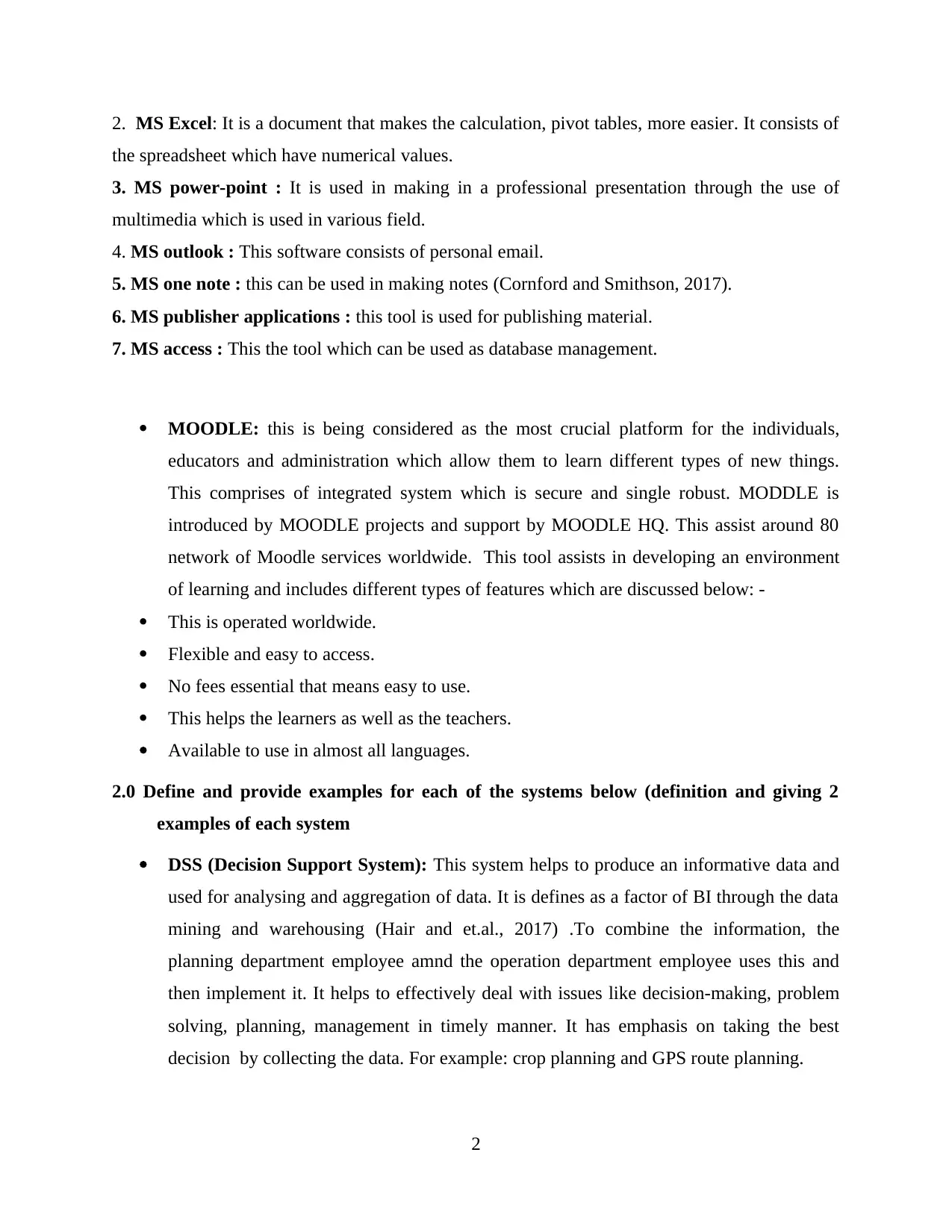
2. MS Excel: It is a document that makes the calculation, pivot tables, more easier. It consists of
the spreadsheet which have numerical values.
3. MS power-point : It is used in making in a professional presentation through the use of
multimedia which is used in various field.
4. MS outlook : This software consists of personal email.
5. MS one note : this can be used in making notes (Cornford and Smithson, 2017).
6. MS publisher applications : this tool is used for publishing material.
7. MS access : This the tool which can be used as database management.
MOODLE: this is being considered as the most crucial platform for the individuals,
educators and administration which allow them to learn different types of new things.
This comprises of integrated system which is secure and single robust. MODDLE is
introduced by MOODLE projects and support by MOODLE HQ. This assist around 80
network of Moodle services worldwide. This tool assists in developing an environment
of learning and includes different types of features which are discussed below: -
This is operated worldwide.
Flexible and easy to access.
No fees essential that means easy to use.
This helps the learners as well as the teachers.
Available to use in almost all languages.
2.0 Define and provide examples for each of the systems below (definition and giving 2
examples of each system
DSS (Decision Support System): This system helps to produce an informative data and
used for analysing and aggregation of data. It is defines as a factor of BI through the data
mining and warehousing (Hair and et.al., 2017) .To combine the information, the
planning department employee amnd the operation department employee uses this and
then implement it. It helps to effectively deal with issues like decision-making, problem
solving, planning, management in timely manner. It has emphasis on taking the best
decision by collecting the data. For example: crop planning and GPS route planning.
2
the spreadsheet which have numerical values.
3. MS power-point : It is used in making in a professional presentation through the use of
multimedia which is used in various field.
4. MS outlook : This software consists of personal email.
5. MS one note : this can be used in making notes (Cornford and Smithson, 2017).
6. MS publisher applications : this tool is used for publishing material.
7. MS access : This the tool which can be used as database management.
MOODLE: this is being considered as the most crucial platform for the individuals,
educators and administration which allow them to learn different types of new things.
This comprises of integrated system which is secure and single robust. MODDLE is
introduced by MOODLE projects and support by MOODLE HQ. This assist around 80
network of Moodle services worldwide. This tool assists in developing an environment
of learning and includes different types of features which are discussed below: -
This is operated worldwide.
Flexible and easy to access.
No fees essential that means easy to use.
This helps the learners as well as the teachers.
Available to use in almost all languages.
2.0 Define and provide examples for each of the systems below (definition and giving 2
examples of each system
DSS (Decision Support System): This system helps to produce an informative data and
used for analysing and aggregation of data. It is defines as a factor of BI through the data
mining and warehousing (Hair and et.al., 2017) .To combine the information, the
planning department employee amnd the operation department employee uses this and
then implement it. It helps to effectively deal with issues like decision-making, problem
solving, planning, management in timely manner. It has emphasis on taking the best
decision by collecting the data. For example: crop planning and GPS route planning.
2
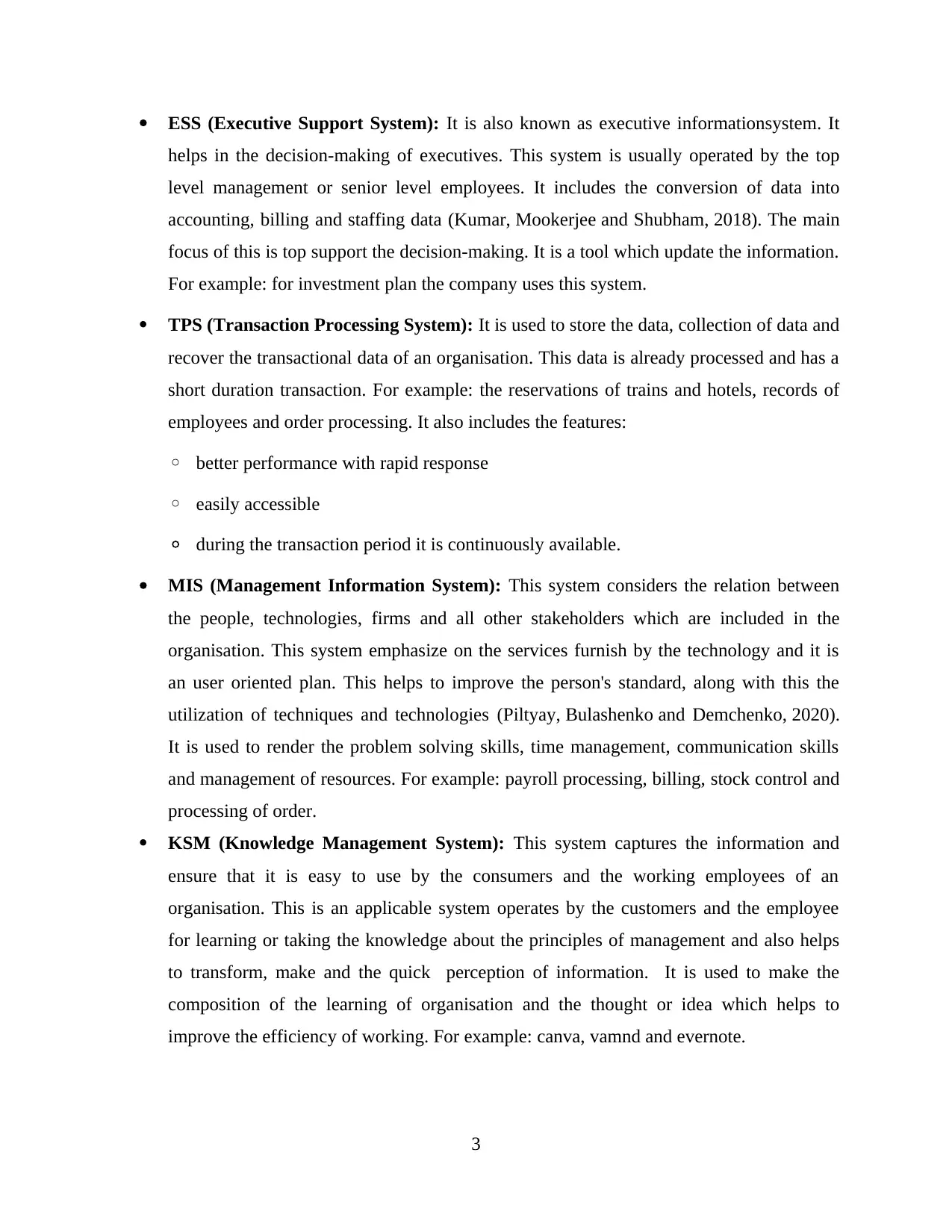
ESS (Executive Support System): It is also known as executive informationsystem. It
helps in the decision-making of executives. This system is usually operated by the top
level management or senior level employees. It includes the conversion of data into
accounting, billing and staffing data (Kumar, Mookerjee and Shubham, 2018). The main
focus of this is top support the decision-making. It is a tool which update the information.
For example: for investment plan the company uses this system.
TPS (Transaction Processing System): It is used to store the data, collection of data and
recover the transactional data of an organisation. This data is already processed and has a
short duration transaction. For example: the reservations of trains and hotels, records of
employees and order processing. It also includes the features:
◦ better performance with rapid response
◦ easily accessible
◦ during the transaction period it is continuously available.
MIS (Management Information System): This system considers the relation between
the people, technologies, firms and all other stakeholders which are included in the
organisation. This system emphasize on the services furnish by the technology and it is
an user oriented plan. This helps to improve the person's standard, along with this the
utilization of techniques and technologies (Piltyay, Bulashenko and Demchenko, 2020).
It is used to render the problem solving skills, time management, communication skills
and management of resources. For example: payroll processing, billing, stock control and
processing of order.
KSM (Knowledge Management System): This system captures the information and
ensure that it is easy to use by the consumers and the working employees of an
organisation. This is an applicable system operates by the customers and the employee
for learning or taking the knowledge about the principles of management and also helps
to transform, make and the quick perception of information. It is used to make the
composition of the learning of organisation and the thought or idea which helps to
improve the efficiency of working. For example: canva, vamnd and evernote.
3
helps in the decision-making of executives. This system is usually operated by the top
level management or senior level employees. It includes the conversion of data into
accounting, billing and staffing data (Kumar, Mookerjee and Shubham, 2018). The main
focus of this is top support the decision-making. It is a tool which update the information.
For example: for investment plan the company uses this system.
TPS (Transaction Processing System): It is used to store the data, collection of data and
recover the transactional data of an organisation. This data is already processed and has a
short duration transaction. For example: the reservations of trains and hotels, records of
employees and order processing. It also includes the features:
◦ better performance with rapid response
◦ easily accessible
◦ during the transaction period it is continuously available.
MIS (Management Information System): This system considers the relation between
the people, technologies, firms and all other stakeholders which are included in the
organisation. This system emphasize on the services furnish by the technology and it is
an user oriented plan. This helps to improve the person's standard, along with this the
utilization of techniques and technologies (Piltyay, Bulashenko and Demchenko, 2020).
It is used to render the problem solving skills, time management, communication skills
and management of resources. For example: payroll processing, billing, stock control and
processing of order.
KSM (Knowledge Management System): This system captures the information and
ensure that it is easy to use by the consumers and the working employees of an
organisation. This is an applicable system operates by the customers and the employee
for learning or taking the knowledge about the principles of management and also helps
to transform, make and the quick perception of information. It is used to make the
composition of the learning of organisation and the thought or idea which helps to
improve the efficiency of working. For example: canva, vamnd and evernote.
3
⊘ This is a preview!⊘
Do you want full access?
Subscribe today to unlock all pages.

Trusted by 1+ million students worldwide
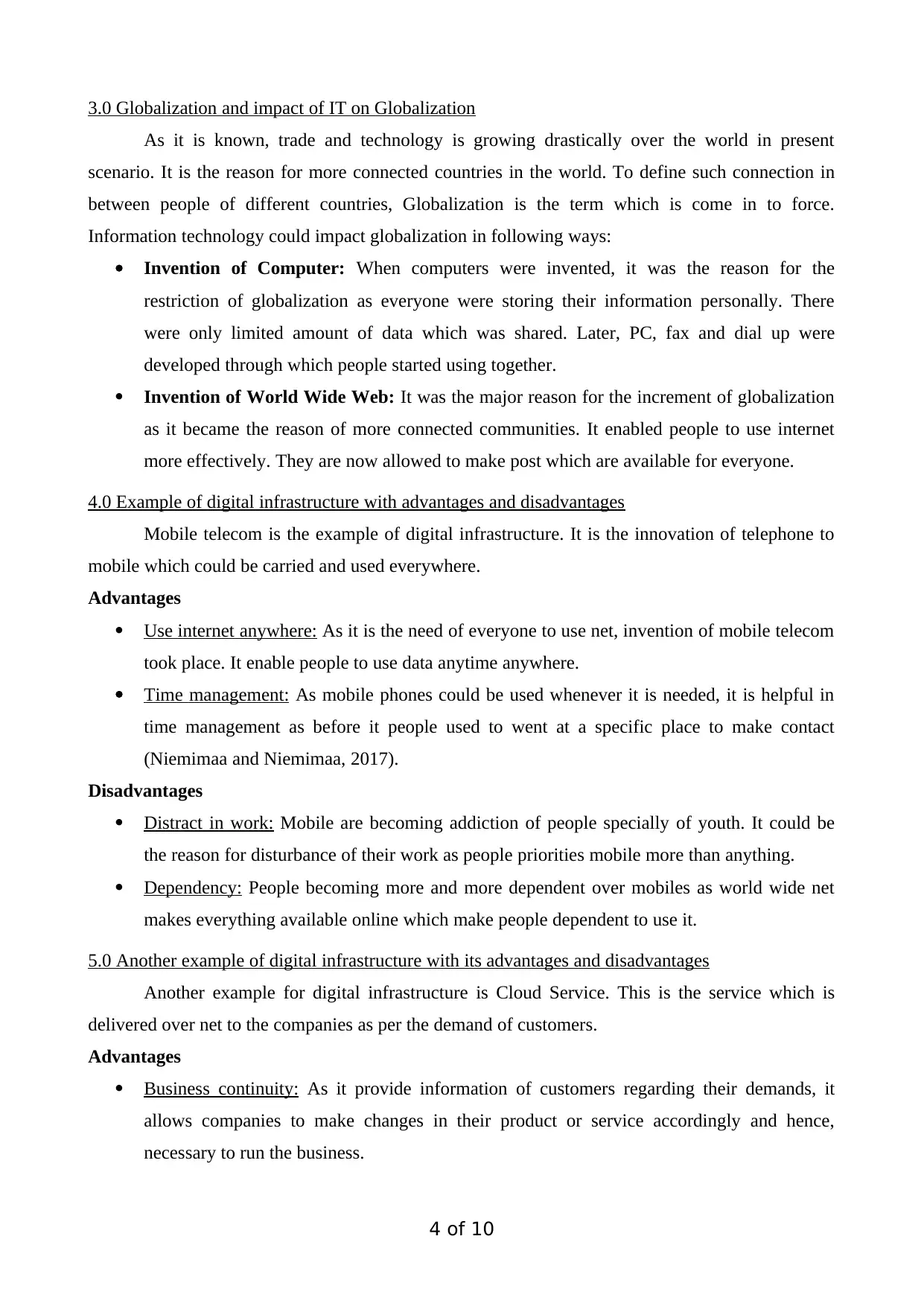
3.0 Globalization and impact of IT on Globalization
As it is known, trade and technology is growing drastically over the world in present
scenario. It is the reason for more connected countries in the world. To define such connection in
between people of different countries, Globalization is the term which is come in to force.
Information technology could impact globalization in following ways:
Invention of Computer: When computers were invented, it was the reason for the
restriction of globalization as everyone were storing their information personally. There
were only limited amount of data which was shared. Later, PC, fax and dial up were
developed through which people started using together.
Invention of World Wide Web: It was the major reason for the increment of globalization
as it became the reason of more connected communities. It enabled people to use internet
more effectively. They are now allowed to make post which are available for everyone.
4.0 Example of digital infrastructure with advantages and disadvantages
Mobile telecom is the example of digital infrastructure. It is the innovation of telephone to
mobile which could be carried and used everywhere.
Advantages
Use internet anywhere: As it is the need of everyone to use net, invention of mobile telecom
took place. It enable people to use data anytime anywhere.
Time management: As mobile phones could be used whenever it is needed, it is helpful in
time management as before it people used to went at a specific place to make contact
(Niemimaa and Niemimaa, 2017).
Disadvantages
Distract in work: Mobile are becoming addiction of people specially of youth. It could be
the reason for disturbance of their work as people priorities mobile more than anything.
Dependency: People becoming more and more dependent over mobiles as world wide net
makes everything available online which make people dependent to use it.
5.0 Another example of digital infrastructure with its advantages and disadvantages
Another example for digital infrastructure is Cloud Service. This is the service which is
delivered over net to the companies as per the demand of customers.
Advantages
Business continuity: As it provide information of customers regarding their demands, it
allows companies to make changes in their product or service accordingly and hence,
necessary to run the business.
4 of 10
As it is known, trade and technology is growing drastically over the world in present
scenario. It is the reason for more connected countries in the world. To define such connection in
between people of different countries, Globalization is the term which is come in to force.
Information technology could impact globalization in following ways:
Invention of Computer: When computers were invented, it was the reason for the
restriction of globalization as everyone were storing their information personally. There
were only limited amount of data which was shared. Later, PC, fax and dial up were
developed through which people started using together.
Invention of World Wide Web: It was the major reason for the increment of globalization
as it became the reason of more connected communities. It enabled people to use internet
more effectively. They are now allowed to make post which are available for everyone.
4.0 Example of digital infrastructure with advantages and disadvantages
Mobile telecom is the example of digital infrastructure. It is the innovation of telephone to
mobile which could be carried and used everywhere.
Advantages
Use internet anywhere: As it is the need of everyone to use net, invention of mobile telecom
took place. It enable people to use data anytime anywhere.
Time management: As mobile phones could be used whenever it is needed, it is helpful in
time management as before it people used to went at a specific place to make contact
(Niemimaa and Niemimaa, 2017).
Disadvantages
Distract in work: Mobile are becoming addiction of people specially of youth. It could be
the reason for disturbance of their work as people priorities mobile more than anything.
Dependency: People becoming more and more dependent over mobiles as world wide net
makes everything available online which make people dependent to use it.
5.0 Another example of digital infrastructure with its advantages and disadvantages
Another example for digital infrastructure is Cloud Service. This is the service which is
delivered over net to the companies as per the demand of customers.
Advantages
Business continuity: As it provide information of customers regarding their demands, it
allows companies to make changes in their product or service accordingly and hence,
necessary to run the business.
4 of 10
Paraphrase This Document
Need a fresh take? Get an instant paraphrase of this document with our AI Paraphraser
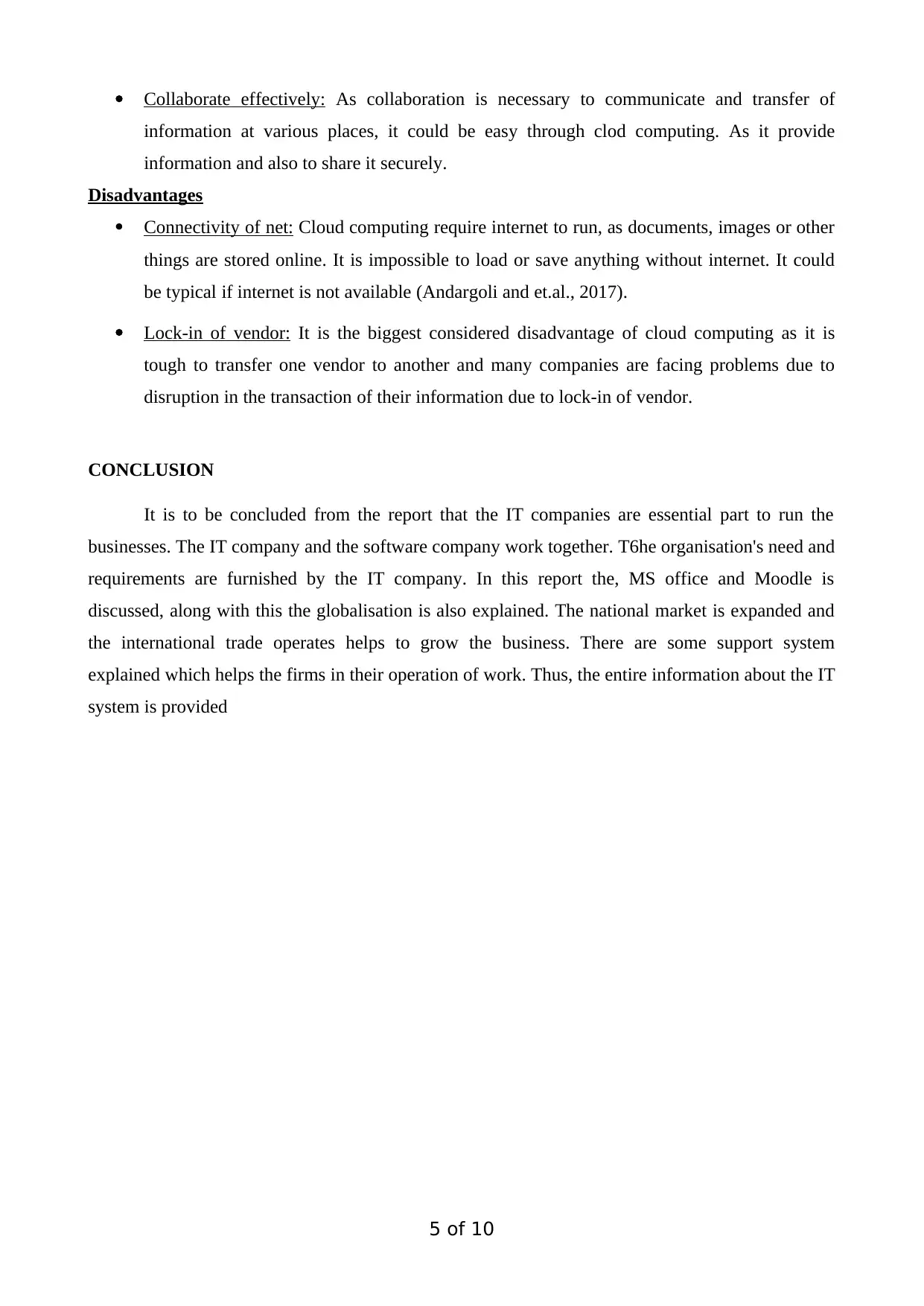
Collaborate effectively: As collaboration is necessary to communicate and transfer of
information at various places, it could be easy through clod computing. As it provide
information and also to share it securely.
Disadvantages
Connectivity of net: Cloud computing require internet to run, as documents, images or other
things are stored online. It is impossible to load or save anything without internet. It could
be typical if internet is not available (Andargoli and et.al., 2017).
Lock-in of vendor: It is the biggest considered disadvantage of cloud computing as it is
tough to transfer one vendor to another and many companies are facing problems due to
disruption in the transaction of their information due to lock-in of vendor.
CONCLUSION
It is to be concluded from the report that the IT companies are essential part to run the
businesses. The IT company and the software company work together. T6he organisation's need and
requirements are furnished by the IT company. In this report the, MS office and Moodle is
discussed, along with this the globalisation is also explained. The national market is expanded and
the international trade operates helps to grow the business. There are some support system
explained which helps the firms in their operation of work. Thus, the entire information about the IT
system is provided
5 of 10
information at various places, it could be easy through clod computing. As it provide
information and also to share it securely.
Disadvantages
Connectivity of net: Cloud computing require internet to run, as documents, images or other
things are stored online. It is impossible to load or save anything without internet. It could
be typical if internet is not available (Andargoli and et.al., 2017).
Lock-in of vendor: It is the biggest considered disadvantage of cloud computing as it is
tough to transfer one vendor to another and many companies are facing problems due to
disruption in the transaction of their information due to lock-in of vendor.
CONCLUSION
It is to be concluded from the report that the IT companies are essential part to run the
businesses. The IT company and the software company work together. T6he organisation's need and
requirements are furnished by the IT company. In this report the, MS office and Moodle is
discussed, along with this the globalisation is also explained. The national market is expanded and
the international trade operates helps to grow the business. There are some support system
explained which helps the firms in their operation of work. Thus, the entire information about the IT
system is provided
5 of 10
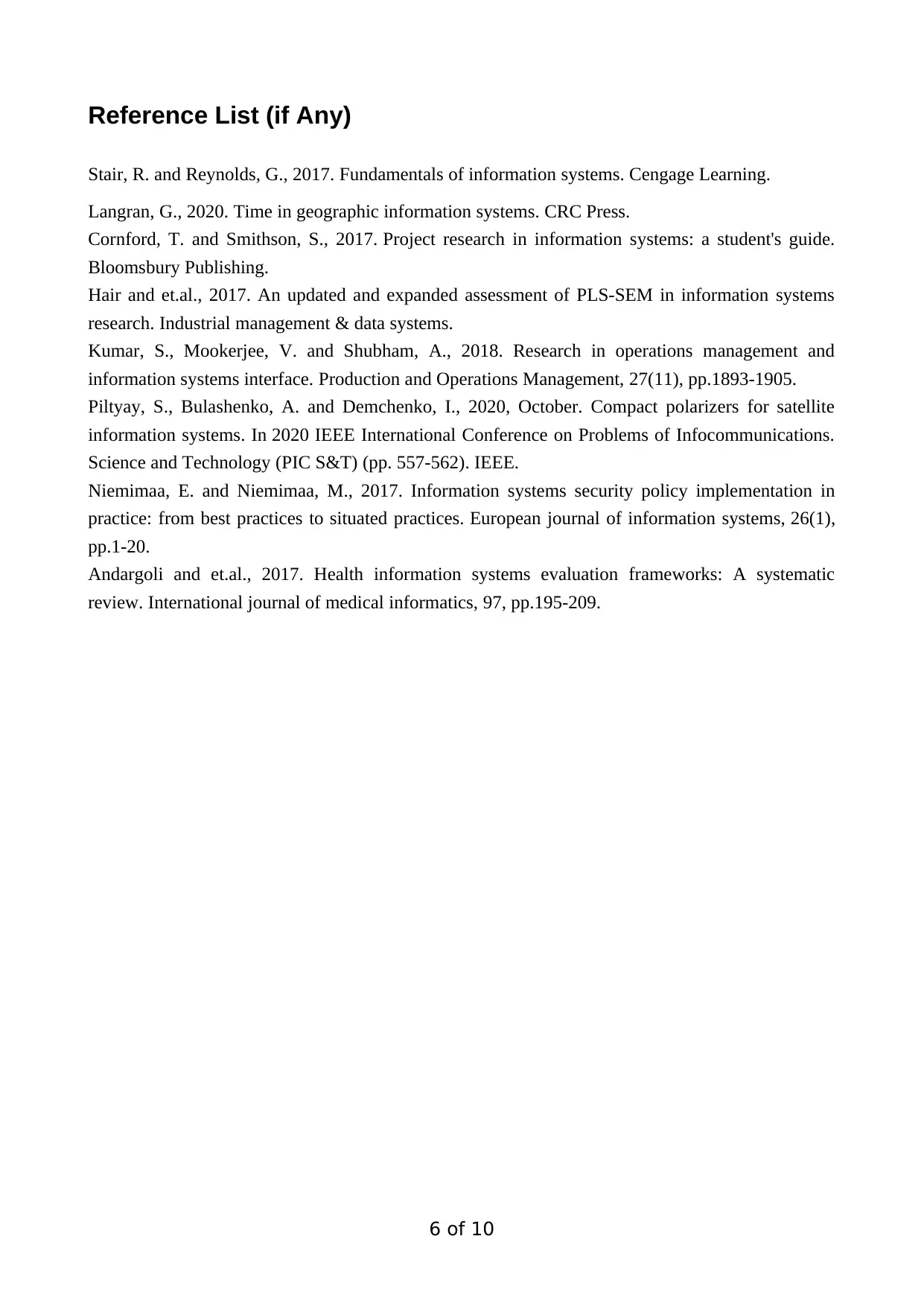
Reference List (if Any)
Stair, R. and Reynolds, G., 2017. Fundamentals of information systems. Cengage Learning.
Langran, G., 2020. Time in geographic information systems. CRC Press.
Cornford, T. and Smithson, S., 2017. Project research in information systems: a student's guide.
Bloomsbury Publishing.
Hair and et.al., 2017. An updated and expanded assessment of PLS-SEM in information systems
research. Industrial management & data systems.
Kumar, S., Mookerjee, V. and Shubham, A., 2018. Research in operations management and
information systems interface. Production and Operations Management, 27(11), pp.1893-1905.
Piltyay, S., Bulashenko, A. and Demchenko, I., 2020, October. Compact polarizers for satellite
information systems. In 2020 IEEE International Conference on Problems of Infocommunications.
Science and Technology (PIC S&T) (pp. 557-562). IEEE.
Niemimaa, E. and Niemimaa, M., 2017. Information systems security policy implementation in
practice: from best practices to situated practices. European journal of information systems, 26(1),
pp.1-20.
Andargoli and et.al., 2017. Health information systems evaluation frameworks: A systematic
review. International journal of medical informatics, 97, pp.195-209.
6 of 10
Stair, R. and Reynolds, G., 2017. Fundamentals of information systems. Cengage Learning.
Langran, G., 2020. Time in geographic information systems. CRC Press.
Cornford, T. and Smithson, S., 2017. Project research in information systems: a student's guide.
Bloomsbury Publishing.
Hair and et.al., 2017. An updated and expanded assessment of PLS-SEM in information systems
research. Industrial management & data systems.
Kumar, S., Mookerjee, V. and Shubham, A., 2018. Research in operations management and
information systems interface. Production and Operations Management, 27(11), pp.1893-1905.
Piltyay, S., Bulashenko, A. and Demchenko, I., 2020, October. Compact polarizers for satellite
information systems. In 2020 IEEE International Conference on Problems of Infocommunications.
Science and Technology (PIC S&T) (pp. 557-562). IEEE.
Niemimaa, E. and Niemimaa, M., 2017. Information systems security policy implementation in
practice: from best practices to situated practices. European journal of information systems, 26(1),
pp.1-20.
Andargoli and et.al., 2017. Health information systems evaluation frameworks: A systematic
review. International journal of medical informatics, 97, pp.195-209.
6 of 10
⊘ This is a preview!⊘
Do you want full access?
Subscribe today to unlock all pages.

Trusted by 1+ million students worldwide
1 out of 9
Related Documents
Your All-in-One AI-Powered Toolkit for Academic Success.
+13062052269
info@desklib.com
Available 24*7 on WhatsApp / Email
![[object Object]](/_next/static/media/star-bottom.7253800d.svg)
Unlock your academic potential
Copyright © 2020–2025 A2Z Services. All Rights Reserved. Developed and managed by ZUCOL.





